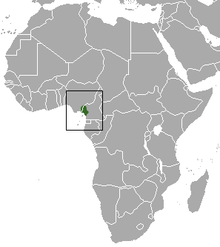Red-eared guenon
| Red-eared guenon | |
|---|---|

| |
| Scientific classification | |
| Domain: | Eukaryota |
| Kingdom: | Animalia |
| Phylum: | Chordata |
| Class: | Mammalia |
| Order: | Primates |
| Suborder: | Haplorhini |
| Infraorder: | Simiiformes |
| Family: | Cercopithecidae |
| Genus: | Cercopithecus |
| Species: | C. erythrotis
|
| Binomial name | |
| Cercopithecus erythrotis Waterhouse, 1838[2]
| |

| |
| Red-eared guenon range | |
The red-eared guenon (Cercopithecus erythrotis), also called red-eared monkey or russet-eared guenon, is a
Description
The red-eared guenon is a small, colourful monkey with distinctive facial markings which involve blue fur around its eyes, a brick-red nose and ears, and yellow cheeks. The silky fur on the body consists of banded brown and pale hairs with grey limbs and a long, red tail. The long tails are partially
Distribution and subspecies
There are two recognised subspecies, which are listed below with their distributions:[5][4]
- Cercopithecus erythrotis camerunensis Hayman, 1940 Cameroon Red-eared Monkey: from the Cross River in south eastern Nigeria and to just north of the Sanaga River in south western Cameroon.
- Cercopithecus erythrotis erythrotis Waterhouse, 1838 Bioko Red-eared Monkey:Bioko island in Equatorial Guinea.
Habitat
The red-eared guenon is found in primary and secondary lowland tropical and sub-montane moist forest, and sometimes lives in close proximity to humans, as on Bioko.[1]

Behaviour and ecology
This section needs additional citations for verification. (July 2023) |
The red-eared guenon is
Threats
The red-eared guenon is threatened by deforestation and by the
References
- ^ . Retrieved 15 November 2021.
- OCLC 62265494.
- ^ "Red-eared Guenon (Cercopithecus erythrotis)". Wildscreen Arkive. Wildscreen. Archived from the original on 2016-11-24. Retrieved 23 November 2016.
- ^ ISBN 978-1408189962.
- ^ "Cercopithecus erythrotis Waterhouse, 1838". Integrated Taxonomic Information System (ITIS) (https://www.itis.gov). Retrieved 23 November 2016.
- ^ "Red-Eared Guenon, Cercopithecus erythrotis | New England Primate Conservancy". neprimateconservancy.org. 2021-11-26. Retrieved 2023-01-24.
- .

